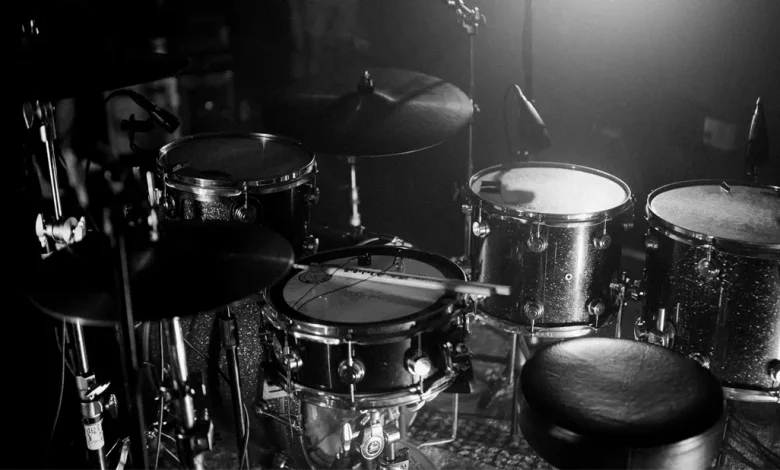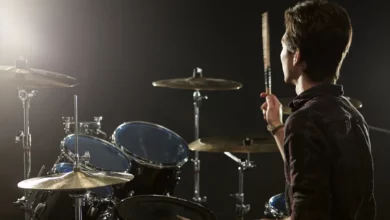
We may earn a commission from the affiliate links on this site. Learn more›
Not so long ago, I wrote an article about paradiddles for Drumming Review. I love paradiddles. Maybe that sounds lame, but after this article, you might feel the same way.
Like a gift that keeps on giving, paradiddles become more fun and more practical the more you utilize them. While you’re getting used to them, they can feel clunky and challenging to play. As you become more familiar, you can start to flow with them.
Eventually, it’ll feel as natural as putting one foot in front of the other. At that point, an almost endless array of creative opportunities opens up.
Here, I’m going to list some ideas for expanding your creative use of paradiddles. We’ll look at single, double, and triple paradiddles, with some inverted ones thrown in for good measure.
These ideas use a base level of orchestration, usually between the hi-hat, snare, and kick. These phrases will be most at home on the kit, but you can condense some of them onto a pad for a different way to practice. So grab some sticks, and let’s get going.

Creative Accents
One way to get creative with paradiddles is to play accents in each phrase. Don’t just accent beats one and three, though, as many people do.
Instead, try accenting some of the +’s, and—in the case of sixteenth notes—accent some of the ‘e’s and ‘a’s, too.
It can be especially effective to move the accents around from bar to bar so that you create some interesting rhythmic variations.
Try some of these ideas with a click, and try them with your favorite tracks. You’ll hear how the accents run with and against the pulse to create interesting rhythmic effects.


Orchestration
Orchestration refers to the act of phrasing a musical idea across multiple instruments. For example, many composers, songwriters, and producers will write some basic melodies and harmonies on a piano or guitar and then move these melodies and harmonies onto multiple instruments afterward.
As drummers, we can orchestrate a paradiddle in many ways. Take a look at the ideas below to understand how to approach this.



You can see that these phrases can work as a groove, all, or in the context of a drum solo. You don’t necessarily need to decide which idea fits into these categories—that could be limiting.
Instead, get used to playing each phrase, and immerse yourself in them for a while. Then, if you feel like experimenting with your own ideas, go ahead.
Subdivision Changes
I find some of these ideas fun. Unfortunately, many drummers become restricted in their use of paradiddles. They don’t move beyond believing that a single paradiddle should be played in straight eighths and a triple paradiddle should be played in sixteenths.
It’s not easy, but if you can become comfortable phrasing a single paradiddle as a set of triplets, you can discover some cool effects.

There are multiple ways for this to work, but one excellent starting place could be playing a standard, straight groove and expanding into your single paradiddle triplets.
You can add some accents to create extra spice and orchestrate the paradiddle for even more variety. Again, I’d recommend practicing these to the click since losing the pulse is easy without even noticing.

It’s also worth practicing this to various tracks before trying it out with other musicians. This effect plays with a listener’s sense of timing, and it can freak other musicians out when the drum kit’s steady pulse seems to evaporate. If you don’t play accurately, you can miss beat one, and everyone will be perplexed!
On the flip side, if you’re confident and you nail it, it sounds really cool. But, of course, it’s pretty common to use the double paradiddle as a fill against an eighth-note hi-hat groove.
Here’s an example of that.

Finally, you can rework the (usually triplet-y) double paradiddle into straight eighths or sixteenths.

You may notice that phrase takes longer to resolve when you phrase each paradiddle into an uncommon subdivision. In the example above, the double paradiddle takes two bars to resolve, unlike the usual one bar.
It’s worth factoring the resolution time into each phrase you experiment with, or you can experiment with leaving your paradiddles unresolved for yet another creative effect.
The Half-Time Feel
This section flows out of the last, but some paradiddles lend themselves to a half-time feel. This can be especially helpful for genres like hard rock, gospel, and dubstep when you want to break a track down with some interesting rhythmic phrases.
Try playing a standard rock groove with eighth notes on the hi-hat. Then, flow from there into a half-time groove, using the triple paradiddle as your base.
Notice that—by adding ghost strokes and a little orchestration—we can create some fantastic half-time effects, which sound intricate and energetic.
When we’re used to doing this, we can shift effortlessly from grooves to linear fills, which merge and flow from one another.


This effect can be achieved with the double paradiddle too—and it sounds slightly different from the triple paradiddle.
Try switching back to a standard, eighth-note rock groove; and then shifting into a double paradiddle groove, split between the ride, kick and snare.
You’ll quickly hear how interesting it is to move between these two different feels and how the double paradiddle gives a different spin on the half-time approach.

Mix and Match
These are some of my favorite ways to use paradiddles, but it can take some practice. The idea here is to use the paradiddle as your base but break it apart and use different sections in other places to create interesting phrases.
You’ll see from the grooves below that I’ve broken the paradiddles into blocks of notes like RL, RR, LR and LL. These blocks can then be shifted around somewhat like Lego, and one block can be glued to another to create a variety of phrases and rhythmic effects.
By adding accents and orchestrating some of the phrases, you can continue to expand the possibilities further.


We can also add some rests into our paradiddle phrases.
This can lead us in yet another creative direction; rather than creating an endless flow of evolving rhythm, adding some breaks can ‘breathe space’ into our music.

Adding It All Together
If you’ve followed this article from start to finish, you’ll have noticed that we’ve often added variety to our paradiddle ideas by adding accents and orchestrating phrases.
It’s possible to take this further by mixing all of our ideas and allowing each to evolve naturally.
It’s also possible to throw paradiddle-diddles into the mix to further develop our creative ideas.


The Bottom Line
Paradiddles can give us so much variety that we can spend hours exploring all options without getting bored. One of their strengths is how they can help us utilize a constant flow of notes that underpin many grooves, fills, and solos, adding momentum and intricacy to our musical ideas. Take your time—learning the drums quickly is no easy feat.
They also give us a handy basis for playing around with accents and exploring orchestration.
Like anything on the drums, you can’t get the most out of the paradiddle without putting time and energy into properly familiarising yourself with it. Having said that, if you’re willing to practice paradiddles in all their various forms, you’ll start to become more and more comfortable with them.
Eventually, it’ll feel like the most natural thing in the world to experiment and play around with them.
Then, when you reach the point that you can flow naturally from one idea to the next, you’ll find some fun, rewarding phrases which can add so much to your grooves, fills, and drum solos.
Try to find any excuse to work the paradiddle into your muscle memory. Tap them out on your car steering wheel when you’re stuck in traffic, tap them on your knees while watching the TV, and play them on the table with straws while in McDonald’s.
When you’re at the practice pad, use only the paradiddle to play along with some of your favorite songs, and keep exploring accents and subdivision changes.
Annoy everyone with your endless paradiddling! Embed them into your system, allowing them to get under your skin. If you can make them natural, they’ll provide you with more creative options than you could possibly know what to do with—and this will only multiply with use.
You won’t exhaust the variety; you’ll only discover more and more of it. Experiment, enjoy, and—as always—happy drumming! If you enjoyed this article, don’t miss out on my post about 7 drum rudiments you NEED to learn.



